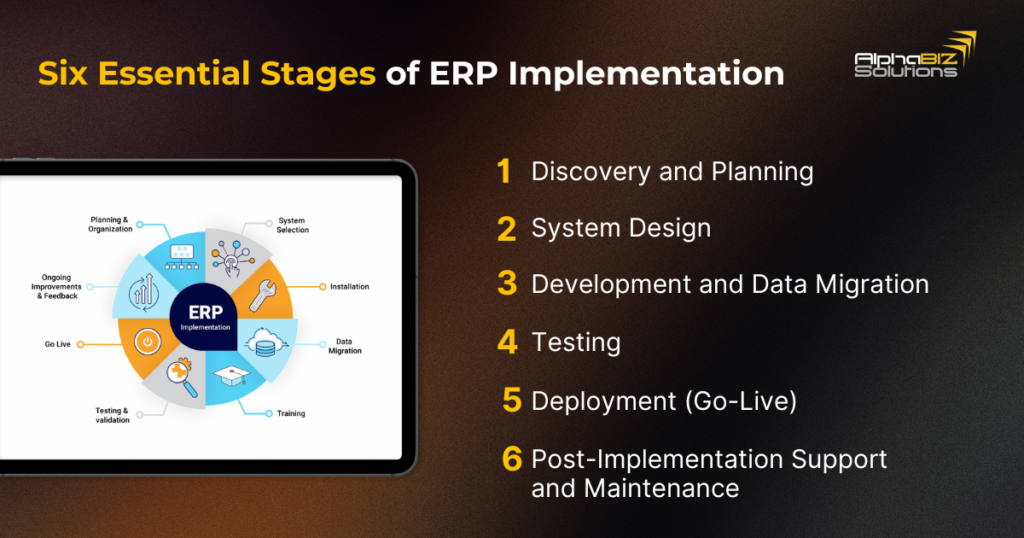Implementing an ERP system can transform how your business operates, improving efficiency, streamlining processes, and positioning you for future growth. However, without a solid plan, it can lead to costly delays, overruns, and business disruptions. The key to a successful ERP implementation lies in a strategic, step-by-step approach tailored to your business.
This guide will walk you through the essential steps and considerations for a smooth ERP rollout, ensuring your business is set up for long-term success.
Why Planning is Crucial for ERP Implementation

ERP systems are integral to managing various functions across your business, from finance to supply chain operations. But poor planning can result in delays and increased costs. In fact, 34.9% of ERP implementations overspend due to challenges in data migration, while 56.1% of delays are caused by insufficient resources .
A well-planned ERP implementation will help mitigate these risks, ensuring smooth transitions and long-term benefits.
The Six Essential Stages of ERP Implementation

A successful ERP implementation typically follows six key stages, each requiring meticulous attention and coordination with your ERP partner.
1. Discovery and Planning
The first stage involves laying the foundation for the project. A cross-functional team is formed to identify the specific requirements of your business. According to a survey, 80% of businesses in Australia and nearby regions are currently building strategic ERP plans, highlighting the importance of this stage .
The project scope, timelines, and roles are established, ensuring everyone is aligned with the project’s goals.
2. System Design
In this stage, you map out your current workflows and identify how the ERP will fit into your business processes. Critical features, configurations, and any necessary customisations are planned. With the growing need for operational efficiency and transparency, more companies are adopting cloud ERP systems to streamline processes
3. Development and Data Migration
During the development stage, the ERP system is configured, and data is migrated. Ensuring that your data is clean and accurate is critical to avoid issues down the line.
Poor data quality is a significant challenge, causing overspending in more than a third of ERP implementations . Additionally, training materials are prepared to ensure smooth adoption by your team.
4. Testing
Before going live, your ERP system undergoes rigorous testing, including unit testing, integration testing, and user acceptance testing (UAT). Testing helps identify any issues and ensures the system meets your business’s needs.
More than 68.7% of companies reported completing ERP implementations on or ahead of schedule when proper testing procedures were in place.
5. Deployment (Go-Live)
The go-live stage is when the ERP system becomes fully operational. A well-planned deployment strategy is crucial to minimise disruption.
Whether you choose a phased rollout or a big bang approach, planning is key. Approximately 36.6% of companies opt for a hybrid approach, blending elements of both strategies.
6. Post-Implementation Support and Maintenance
After deployment, ongoing support and maintenance are critical to ensure your ERP continues to meet your business needs. Regular system updates, training, and troubleshooting are necessary to keep the system running efficiently.
ERP implementation improves key business processes for 97% of companies, so maintaining the system is essential for continued success.
Choosing the Right ERP Implementation Strategy

There is no one-size-fits-all approach to ERP implementation. The best strategy for your business depends on factors like risk tolerance, budget, and timeline.
1. Big Bang Implementation
With the big bang approach, the entire ERP system is deployed at once. While this is faster, it carries a higher risk of disruption if issues arise during the transition.
2. Phased Rollout
A phased rollout involves implementing the ERP system gradually, module by module or department by department. This reduces risk but takes longer to complete.
3. Parallel Adoption
This approach allows the legacy system to run alongside the new ERP during the transition. It minimises disruption but can be resource-intensive, as teams manage two systems at once.
4. Hybrid Approach
A hybrid approach blends big bang and phased rollouts, deploying critical modules immediately while rolling out other features gradually.
How AlphaBiz Solutions Ensures a Successful ERP Implementation
At AlphaBiz Solutions, we understand that every business is unique, and that’s why we offer tailored ERP solutions designed to meet your specific needs. Whether you’re in manufacturing, project & job costing, or construction, our team works closely with you to ensure a smooth ERP rollout.
We follow a structured implementation process, starting with a detailed discovery phase, defining your business’s goals, and customising the ERP system to fit your workflows. Our experts guide you through every step, ensuring minimal disruption and maximum efficiency.
As ERP adoption continues to grow in Australia, with the market projected to reach US$1.03 billion by 2028 , we ensure that your business stays ahead of the curve with a solution that drives growth and efficiency.
Final Thoughts
ERP implementation is a significant undertaking, but with the right strategy and a trusted partner like AlphaBiz Solutions, you can transform your business for the better. From planning and deployment to post-implementation support, we ensure that every stage of your ERP journey is seamless and successful.
To learn more about how AlphaBiz Solutions can help with your ERP implementation, book a demo with our team today.





